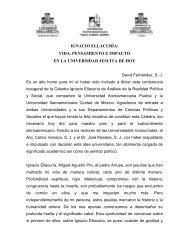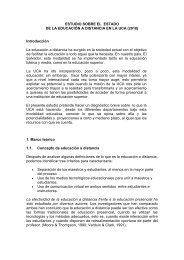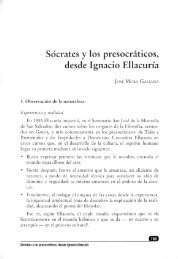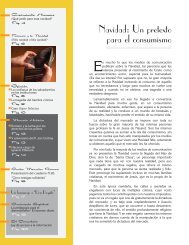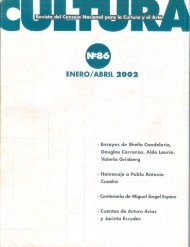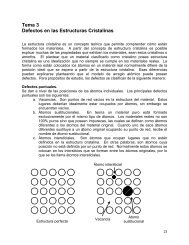Cultura política de la democracia en El Salvador, 2010
Cultura política de la democracia en El Salvador, 2010
Cultura política de la democracia en El Salvador, 2010
Create successful ePaper yourself
Turn your PDF publications into a flip-book with our unique Google optimized e-Paper software.
<strong>Cultura</strong> <strong>política</strong> <strong>de</strong> <strong>la</strong> <strong>de</strong>mocracia <strong>en</strong> <strong>El</strong> <strong>Salvador</strong>, <strong>2010</strong>: Capítulo IV. Estado <strong>de</strong> <strong>de</strong>recho, criminalidad, <strong>de</strong>lincu<strong>en</strong>cia y corrupción<br />
<strong>de</strong>mocracia. <strong>El</strong> fracaso <strong>de</strong> varias <strong>política</strong>s <strong>de</strong> seguridad, el crecimi<strong>en</strong>to <strong>de</strong> grupos criminales como <strong>la</strong>s maras<br />
juv<strong>en</strong>iles y <strong>la</strong>s bandas <strong>de</strong> narcotráfico y el <strong>de</strong>stape por parte <strong>de</strong> <strong>la</strong> pr<strong>en</strong>sa <strong>de</strong>l involucrami<strong>en</strong>to <strong>de</strong> algunos altos<br />
funcionarios públicos <strong>en</strong> activida<strong>de</strong>s criminales podrían estar contribuy<strong>en</strong>do a un contexto <strong>de</strong> erosión <strong>en</strong> el respaldo<br />
al Estado <strong>de</strong> <strong>de</strong>recho.<br />
Belice<br />
Jamaica<br />
V<strong>en</strong>ezue<strong>la</strong><br />
Brasil<br />
Guyana<br />
Estados Unidos<br />
República Dominicana<br />
Surinam<br />
Colombia<br />
Paraguay<br />
Panamá<br />
Canadá<br />
Guatema<strong>la</strong><br />
México<br />
Costa Rica<br />
Bolivia<br />
Arg<strong>en</strong>tina<br />
Chile<br />
Nicaragua<br />
Honduras<br />
Trinidad & Tobago<br />
Uruguay<br />
Perú<br />
<strong>El</strong> <strong>Salvador</strong><br />
Ecuador<br />
47.4<br />
45.5<br />
51.7<br />
51.6<br />
49.5<br />
56.4<br />
55.0<br />
54.2<br />
54.0<br />
61.0<br />
55.5<br />
63.8<br />
63.7<br />
62.9<br />
62.5<br />
61.6<br />
60.9<br />
68.2<br />
67.3<br />
66.1<br />
70.3<br />
69.0<br />
0 20 40 60 80<br />
Apoyo al estado <strong>de</strong> <strong>de</strong>recho<br />
76.7<br />
72.9<br />
78.4<br />
95% Intervalo <strong>de</strong> confianza (Efecto <strong>de</strong> diseño incorporado)<br />
Fu<strong>en</strong>te: Barómetro <strong>de</strong> <strong>la</strong>s Américas por LAPOP<br />
Gráfico IV.24. Apoyo hacia el respeto por el estado <strong>de</strong> <strong>de</strong>recho <strong>en</strong> perspectiva comparativa.<br />
Para po<strong>de</strong>r establecer los factores inmediatos que se <strong>en</strong>cu<strong>en</strong>tran <strong>de</strong>trás <strong>de</strong>l respaldo al Estado <strong>de</strong> <strong>de</strong>recho,<br />
procedimos a realizar una regresión logística usando el respeto por el Estado <strong>de</strong> <strong>de</strong>recho como <strong>la</strong> variable<br />
<strong>de</strong>p<strong>en</strong>di<strong>en</strong>te y los datos sobre inseguridad, victimización y confianza <strong>en</strong> <strong>la</strong>s instituciones <strong>de</strong> seguridad y <strong>de</strong> justicia<br />
como <strong>la</strong>s variables in<strong>de</strong>p<strong>en</strong>di<strong>en</strong>tes. A<strong>de</strong>más, se incluyeron <strong>la</strong>s variables <strong>de</strong>mográficas <strong>de</strong> control. Los resultados<br />
indican que <strong>de</strong> todas <strong>la</strong>s variables re<strong>la</strong>cionadas con el tema <strong>de</strong> <strong>la</strong> seguridad y <strong>la</strong>s instituciones <strong>de</strong> justicia, so<strong>la</strong>m<strong>en</strong>te<br />
<strong>la</strong> percepción <strong>de</strong> inseguridad y <strong>la</strong> confianza <strong>en</strong> el sistema <strong>de</strong> justicia figuran como predictores <strong>de</strong>l respeto al Estado<br />
<strong>de</strong> <strong>de</strong>recho. Esto es, <strong>en</strong> <strong>la</strong> medida <strong>en</strong> que los ciudadanos percib<strong>en</strong> más inseguridad, <strong>en</strong> esa medida disminuye su<br />
apoyo al Estado <strong>de</strong> <strong>de</strong>recho y se <strong>en</strong>contrarían más dispuestos a aprobar que <strong>la</strong> policía pase por alto <strong>la</strong>s leyes con tal<br />
<strong>de</strong> combatir <strong>la</strong> <strong>de</strong>lincu<strong>en</strong>cia. En el caso <strong>de</strong>l sistema <strong>de</strong> justicia, los resultados <strong>de</strong> <strong>la</strong> regresión indican que una<br />
elevada confianza <strong>en</strong> <strong>la</strong>s instituciones <strong>de</strong>l sistema <strong>de</strong> justicia contribuye a mant<strong>en</strong>er el respeto ciudadano por el<br />
Estado <strong>de</strong> <strong>de</strong>recho.<br />
©LAPOP: Página 107





